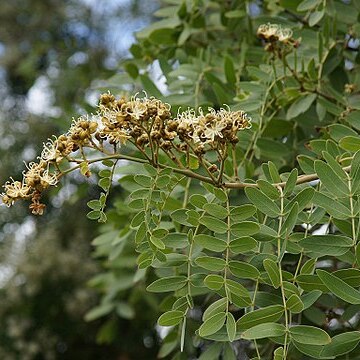A tree. It grows 5-15 m tall. The crown can be flat or rounded. The young branches are hairy. The bark is rough and grey. The leaves have leaflets along the stalk. There are 4-6 pairs of leaflets. These are 2-9 cm long by 1-3 cm wide. The flower panicles are 30 cm long. The petals are white. The fruit are pods 4-9 cm long by 2-3 cm wide. The seeds are dark brown and about 1.5 cm long.
Leaves: stipules intrapetiolar, 3–5 mm long, connate at base, bicuspidate, caducous; petiole with rachis (3)5–20 cm long; leaflets in (2)4–6(8) pairs, (1)2–8.5(11.5) × (0.6)1–3.3(5.6) cm, oblong-elliptic, ovate-oblong or obovate-oblong, asymmetrically cuneate at base, obtuse to emarginate at apex, margins white pubescent.
Panicles up to 30 cm long and wide, brown pubescent; bracts 2–10 mm long, usually at least half as long as the bracteoles; bracteoles 7–10 × 6–9 mm.
Tree 5–15 m tall, with flat or rounded spreading crown, but sometimes shrubby or flowering from coppice shoots 0.3–2 m high; bark rough, grey.
Petals white, the larger one 6.5–9 × 4–5 mm, ovate, shortly clawed, others 3–8 × 0.5–3 mm, narrowly obovate to spathulate or linear.
Pods 4–9 × 2–3.2 cm, obovate-oblong to oblong, brown tomentose.
Sepals 2.5–4.5 × 1.5 mm, oblong, non-contiguous.
Young branches pubescent, glabrescent.
Seeds dark brown, 1.3–1.6 × 1–1.5 cm.


